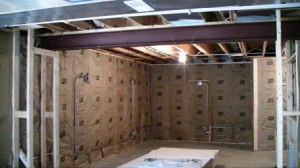Insulating Your Finished Basement Project
0 Comments | Posted by armchairbuilder in Basement Finish, Quality Check
By insulating your new finished basement you will create a cozy space that will actually improve the energy efficiency of your home. Believe it or not, most new homes didn’t get basement insulation until recently. This is crazy since up to 30% of your home’s energy loss is through the basement walls. So in this post, we will discuss the different benefits of insulating your basement as well as the proper techniques for installation.
Benefits of Insulation: We just mentioned the biggest benefit of basement insulation; your space will be much more cozy and comfortable. By adding insulation to your space, you will help disguise the fact that you are actually underground. Basements are notorious for being cool and damp. Another huge benefit of insulating your new space is the energy savings you will see from it. It’s crazy that most homes you go into today don’t have any insulation in their unfinished basement. If you look at the R-values of concrete or concrete block (.64 and 1.11 respectively), you will see how much energy loss is through your basement walls. Don’t forget, a good portion of you basement wall is above grade…anywhere from 10″ to 2′. So you have an exposed wall that has almost no insulation value to it. Compare the meager R-values for the foundation wall mentioned above to your typical R-15 for your upstairs walls and you see the disconnect. You will save an additional $250-$350 per year in energy savings with an R-10 basement wall insulation. Sound control is another great benefit you will see from the insulation in your basement. While shooting the quality check video for insulation, we couldn’t believe the difference in the sound characteristics of our finished basement project. After insulating, the echo was gone and the outside world was forgotten. This was particularly important in our space since it was going to be used for a theater room. You can also eliminate the sound transmission from the upstairs if you insulate between the joist bays above your new finished space. This is a must if you intend to use your new finished basement as a rental unit.
Quality Check: Your fiberglass batt insulation should be installed so it fits neatly within the stud space with no gaps. Be sure the material is not compressed. Compressing the material can take away the R-value. This is because the key element to insulation is the air pockets between the fibers. Also make sure there are no overlaps, especially if you are using kraft faced batt insulation. You don’t want to enclose the insulation between two vapor barriers as this will prevent moisture from getting out. As we all know, trapped moisture can lead to mold. I also like to maintain an air gap between the framed wall with insulation and the foundation wall. This space will help to dry out the space if moisture makes its way in. One other quality initiative when insulating with fiberglass insulation, make sure your contractor cuts neatly around all electrical boxes. I would also recommend using an expandable foam behind the electrical boxes. This will prevent drafts through your outlets and switches.
Insulation Options: Fiberglass batts are currently the most common insulation used in finished basements. The ease of installation as well as the low cost make it the material of choice for most people. Another option would be to use a foam board up against the foundation wall and then frame your wall in front of this. This method is a little more expensive but does provide a layer of moisture protection. A more expensive option is to go with a sprayed expansive foam (open or closed cell). These can be three to six times the cost of fiberglass batts so I typically don’t consider them on my projects. If your current unfinished basement already has roll insulation installed, you could frame your new wall in front of it. Just make sure you don’t compress the existing insulation with the newly framed wall. This will diminish the R-value. One other option you may want to consider…an insulation board for the floor. Most basement floors are not insulated in any way. I would consider this if you decide to go with a hard surface floor. The energy savings you get by insulating your basement floor is minimal but you will probably notice a difference in comfort level.
Check out our latest video, Insulation Quality Check, Finished Basement for more details on how to check that your insulation contractor has done a quality job.


